How to read a coupon
Reading coupons.
For such a little piece of paper, there is a lot of information to be found on a coupon. I consider coupons to be pretty important, and like any important document, you need to read the fine print.
So if you never have read the fine print, or you have but are still confused and unsure of what some of the information means, keep reading…
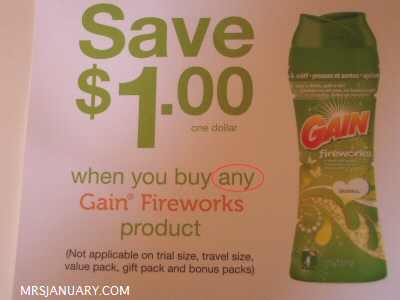
Here we have the dollar value of the coupon and the product that it is valid on. The wording says “when you buy ANY Gain Fireworks product”, meaning it is valid on any size and scent variety. Don’t worry about what the picture shows, the wording is what matters.

Other coupons will specify the size or flavor/scent.
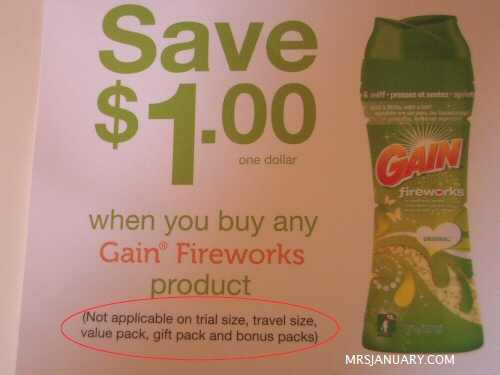
Right next to the product specifications, you will find any other restrictions of the coupon such as “not valid on trial size”.
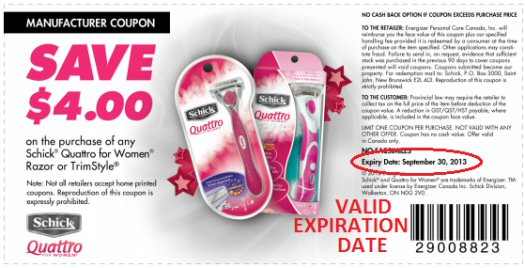
On either the top or the bottom of the coupon you will see the expiration date and the words “manufacturer coupon” (some coupons do not say manufacturer coupon – in this case, you may want to check with the manufacturer themselves to make sure that the coupon was created by them and that it’s valid).
There is a lot of information here, which is separated for the Dealer and the Consumer/Customer.
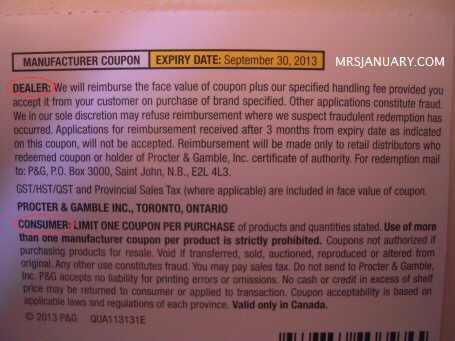
The Dealer is the store. The information for them is this:
- They will be reimbursed for the value of the coupon, plus a handling fee.
- They may be refused reimbursement by the company if fraud is suspected.
- Coupons submitted 3 to 12 months (depending on the coupon) after the expiration date will not be accepted.
- The mailing address to send the coupon for redemption.
The Consumer is you, and the fine print has a lot of important information that you need to be aware of.
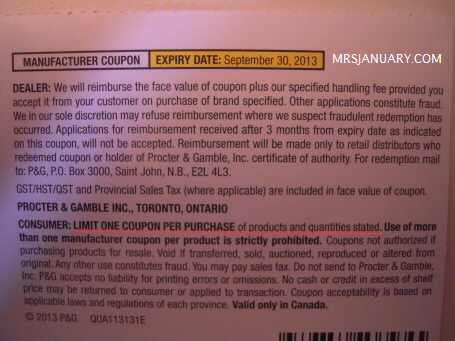
““Limit one coupon per purchase” means that you can only use one coupon per item purchased. This means if you have 4 coupons you can buy 4 items.
This is different than “one coupon per customer“. Even if you have 4 coupons, retailers will only let you use one. If you’re shopping with three other people, then you can use all 4 coupons since you are 4 customers.
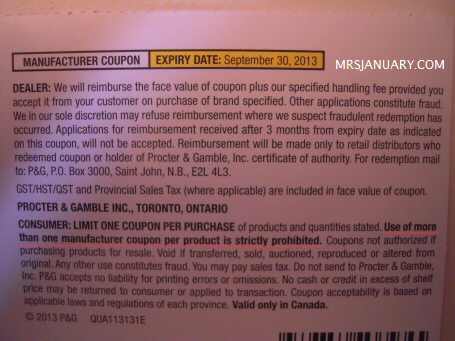
“Use of more than one manufacturer coupon per product is strictly prohibited” means that this coupon is not stackable (some stores allow coupon stacking in Canada). The restrictions of the coupon override store policy so even if a store does allow coupon stacking, coupons with this phrase cannot be stacked.
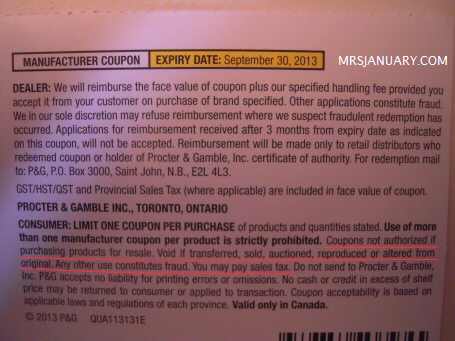
This next bit of information is pretty standard and will appear in some form on most coupons:
- You cannot use a coupon if you are purchasing items for resale.
- The coupon is void if it is altered or reproduced from the original.
- You may have to pay sales tax on the item.
When it comes to sales tax, if you are purchasing an item that costs $3.99 and you have a $2 coupon, you will be taxed on the full $3.99 and then have the $2 deducted from the grand total.
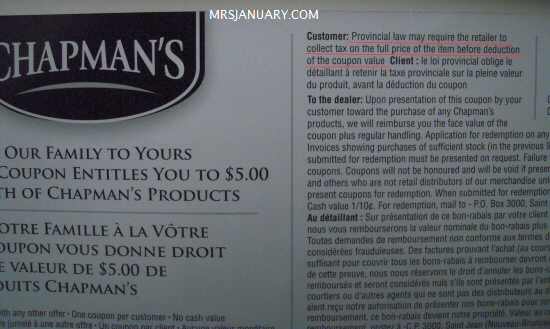
When you have a coupon like the $4/$5 Chapmans or $1 Colgate-Palmolive call in (you can get these coupons from the company) that will often get you a free product when used during a great sale, you still have to pay the taxes, because it is not a “FREE” coupon (Free Product Coupon or FPC).
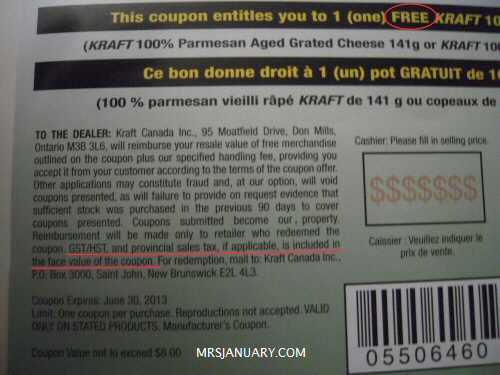
When you have a Free Product Coupon, it is stated on the coupon that sales tax, if applicable, is included in the face value of the coupon. It is “applicable” depending on the province that you live in and their specific sales tax – meaning that you may or may not have to pay sales tax on free items.
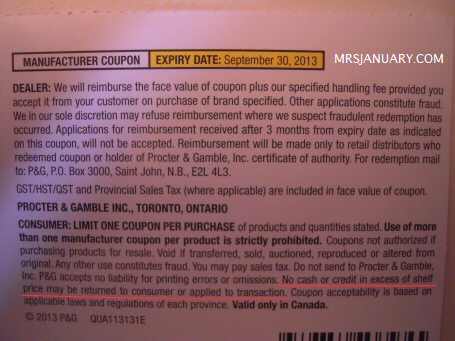
“No cash or credit in excess of shelf price may be returned to the consumer or applied to transactions.” – This means that if the coupon is valued at $1 and the item only costs $0.50, the retailer is not supposed to give you the $0.50 overage. This only recently started appearing on P&G coupons and so far is the only manufacturer that has this restriction.
And there you have it, all the coupon fine print decoded. Now, all coupons vary slightly, but most of the information is pretty standard. And remember, if part of the information is missing, it may be a fake coupon.
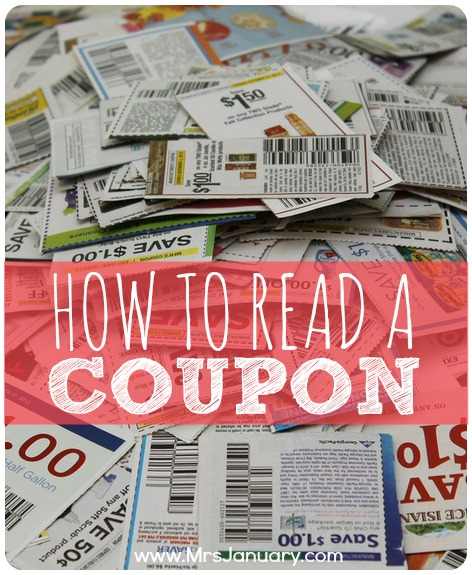

Comments
I always have a problem with “one coupon per purchase”. The cashiers interpret this as “one per customer”. The cashiers need better coupon training. Even the head cashiers and managers don’t know half the time.
I also have the same problem
Agreed. This is the only issue that comes up for me. I can usually explain it, but there have been times where they wanted to ring in all those items separately “just to be sure”. (such as with the $1.50 off greenworks at SDM recently).
For the most part I just try to stick with cashiers I’ve used before that have a good understanding of coupons so I know I won’t run into any problems.
I’ve had the same issue. There is 1 supervisor at the Atlantic Superstore I shop at that is convinced that statement means you can only use 1 coupon. And she is not nice about it :-(.
With FPC, I’ve only ONCE had them discount the tax. Do others have that issue?? I don’t bother pushing it because I think it would just cause a huge headache.
I’ve had that problem too and I’m pretty sure it’s like everyone else says…lack of cashier training.
I also get the same problem with “one per purchase”!! It is very frustrating!! For instance, the MAXI by my house always gives such a hard time with any coupon that I don’t even got here anymore AT ALL!!! I prefer to price match at Walmart and I find the cahiers there better trained with coupons then any other store! I myself used to train cashiers years ago in a grocery store and the coupon policy training wasn’t very clearly explained in their training manual. With couponing being so popular nowadays, they definitely should review their training methods!!!
I don’t understand your explanation of taxes for FPCs. “sales tax, if applicable, is included in the face value of the coupon” This sounds like taxes will be covered if they are applicable, and if taxes aren’t applicable, then there are no taxes to be paid. So whether or not taxes are applicable in your province, you should NOT be paying tax on a FPC. Am I misunderstanding something?
You’re right you should not pay tax on a FPC. The only reason coupons say “sales tax if applicable” is because the manufacturer does not know in which province the coupon will be redeemed an taxes vary by province. Hope that helps!
Retailers need to train their staff at all levels on coupons. The worse is SDM but after working for them for 3 months before quiting I cant blame the cashiers because in my experience I was left alone without even the knowledge on how to call someone within 20 mins of my first shift because they were understaffed and had no one to train me and others needed to take their breaks (It went on for three months without any training before I got fed up and quit)and apparently this is how shoppers are run.
What about dates. Some coupons have 02/04/2014 which one is the month and which the day. Some time I have problems because the cashier does know if the day came first or the month, so she doesn’t accept the coupon.